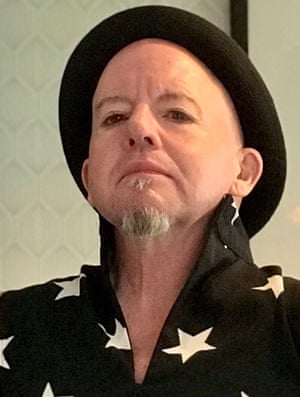[ad_1]
I took this shot in 1995 in my home studio in Highbury Hill, London. At that point, I was in a liminal state with my gender: I was moving from being perceived as female to being perceived as male, but really I was coming to terms with the fact I was born intersex.
I was not transitioning. I had no interest in moving from one fixed point to another. The spaces in-between have always been so much more interesting to me. But this period felt like a turning point in my uncovering the ambiguity in my gender that had always been there. I felt it needed documenting.
For my whole life, I was terrified of not being perceived as adequately feminine, both by straight people and by the lesbian community I was a part of. Because of that fear, I had plucked out the hairs sprouting on my chin – I literally pulled them out with tweezers as soon as they were visible. But I had entered a competition for Drag Kings at the National Film Theatre, and my partner at the time was more into my masculinity than my femininity, so it felt like the right time to come to accept my body.
I went to Italy for a month, and let my beard grow out for the very first time. It was intensely liberating. It felt like coming to terms with myself. When I came back to London I kept it. This photo matters to me because it’s ambiguous: I’m sporting the beard, and playing with masculinity in my pose, but the blue mascara in my facial hair and makeup on my face still softens the shot. It felt accurate and honest, in terms of where I was at that period of my life.
Self-portraiture is central to my work: it is a way of me understanding, responding to and coming to terms with my difference. I was born with an intersex variation, and when puberty hit I developed asymmetrically: one breast was much larger than the other, for example.
For years I hid it. I hid what made me different, and I dealt with years of abuse for looking different, for being a little fat, for not conforming. My mother was gorgeous — fashion-model beautiful — and I didn’t take after her. I destroyed almost every picture that survives of me from those years because I felt disgusting.
Self-portraiture was a way of letting other people see me as I see myself. It was never a narcissistic project – I was never interested in being more beautiful or more attractive than other people – but it was an attempt to recuperate a sense of self and worth after years of that being taken away from me.
I have been photographed and filmed a lot during my life, and much of it presents an image of me that I find absolutely devastating. Self-portraiture was me taking a stand, both for myself and people like me who differ from the norm. Because, while I am the subject of much of my work, it isn’t purely about me. When people talk about the self-portraiture or confessional writing, there’s often a pejorative edge to it, as though you’re being self-indulgent or as if there’s something wrong with it.
But I think the real question is why you make yourself the subject of your art, and what your goal is. Is it to receive absolution? I don’t need that. Is it to receive attention? Because I already get plenty. For me, I’m presenting myself in the hope that others like me will understand that their difference is valuable, that they can be out and proud and unapologetic, that they do not have to conform.
Self-portraiture has been popular among women and queer people and minorities throughout time, from Claude Cahun last century to Zanele Muholi today. I think for us, and for me, it’s because we realise that the personal is political. This is our form of resistance.
There’s now an interest in queer photography and queer photographers. I don’t know how deep that is, or how long it will last. When the year ends and we no longer have the 50th anniversary of Stonewall as a news hook, will the media still make space for us? Will galleries still show our work? Will audiences who aren’t queer still care? Watch this space.
• Del LaGrace Volcano’s work can be seen at Kiss My Genders at the Hayward Gallery, London, until 8 September.
Del LaGrace Volcano’s CV

Born: Orange, California, 1957.
Training: Photography at the San Francisco Art Institute and a Masters in Photographic Studies at the University of Derby.
Influences: Angela Davis, Claude Cahun, James Baldwin and Lee Miller.
High point: ‘Meeting and selling a vintage hand-coloured print of The Ceremony, one of my earlier works, to Lilly Wachowski, co-director of The Matrix.’
Low point: ‘The many times I have been rejected for arts funding grants.’
Top tip: ‘Persistence pays off.’
[ad_2]
READ SOURCE


